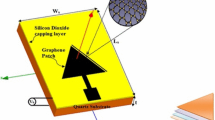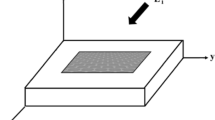Abstract
The graphene patch microstrip antenna has been investigated for 600 GHz applications. The graphene material introduces a reconfigurable surface conductivity in a terahertz frequency band. The input impedance is calculated using the finite integral technique. A five-lumped element equivalent circuit for graphene patch microstrip antenna has been investigated. The values of the lumped element equivalent circuit are optimized using the particle swarm optimization techniques. The optimization is performed to minimize the mean square error between the input impedance of the finite integral and that calculated by the equivalent circuit model. The effect of varying the grapheme material, chemical potential and relaxation time on the radiation characteristics of the graphene patch microstrip antenna has been investigated. An improved new equivalent circuit model has been introduced to best fit the input impedance using a rational function and PSO. The Cauer’s realization method is used to synthesize a new lumped-element equivalent circuits.











Similar content being viewed by others
References
Galoda, S., & Singh, G. (2007). Terahertz technology an emerging electromagnetic spectrum. In Proceedings of the international conference on information and communication technology (IICT-2007), pp. 482–486, Dehradoon, India.
Jha, K. R., & Singh, G. (2014). Terahertz planar antennas for next generation communication. Dordrecht: Springer.
El-Nawawy, M., Allam, A. M., & Korzec, D. (2011). The design of a 0.35 THz microstrip patch antenna on LTCC substrate. Electrical and Electronic Engineering, 1(1), 1–4.
Sharma, A., & Singh, G. (2009). Rectangular microstirp patch antenna design at THz frequency for short distance wireless communication systems. Journal Infrared Millimeter Terahertz Waves, 1(30), 1–7.
Bao, W. (2012). Electrical and mechanical properties of graphene. Ph.D. thesis, University of California, Riverside, USA.
Choi, W., & Lee, J. (2012). Graphene: Synthesis and applications. New York, USA: CRC Press, Taylor and Francis Group.
Malhat, H. A., Zainud-Deen, S. H., & Gaber, S. M. (2014). Circularly polarized graphene based transmitarray for terahertz applications. Progress in Electromagnetics Research M (PIER M), 36, 185–191.
Rouhi, N., Capdevila, S., Jain, D., Zand, K., Wang, Y., Brown, E., et al. (2012). Terahertz graphene optics. Nano Research journal, 5(10), 667–678.
Tamagnone, M., Gómez-Díaz, J. S., Mosig, J. R., & Perruisseau-Carrier, J. (2012). Analysis and design of terahertz antennas based on plasmonic resonant graphene sheets. Journal of Applied Physics, 112(11), 114915.
Tamagnone, M., Gómez-Díaz, J. S., Mosig, J. R., & Perruisseau-Carrier, J. (2012). Reconfigurable terahertz THz plasmonic antenna concept using a graphene stack. Applied Physics Letters, 101(21), 214102.
Bahl, I. (2013). Lumped elements for RF and microwave circuits. Norwood, MA: Artech House.
El-Doda, S. I. (2007). Equivalent, circuits model for antennas. M.Sc. thesis, Faculty of Electronic Engineering, Menoufia University, Egypt.
Zainud-Deen, S. H., El-Doda, S. I., Awadalla, K. H., & Sharshar, H. A. (2008). The relation between lumped-element circuit models for cylindrical dielectric resonator and antenna parameters using MBPE. Progress in Electromagnetics Research M (PIER M), 1, 79–93.
Mahmoud, K. R. (2008). Analysis of smart antenna arrays using optimization techniques. Ph.D. thesis, Faculty of Engineering, Helwan University, Egypt.
Zhou, X., & Pan, G. W. (2006). Application of physical spline finite element method (PSFEM) to full wave analysis of waveguide. Progress in Electromagnetics Research, 60, 19–41.
Clemens, M., & Weiland, T. (2001). Discrete electromagnetism with the finite integration technique. Progress in Electromagnetics Research, PIER, 32, 65–87.
Hassan, W. M. (2009). Scattering from different objects using finite difference frequency domain and applications. M.Sc. thesis, Faculty of Electronic Engineering, Menoufia University, Egypt.
Liao, Y., Hubing, T. H., & Su, D. (2012). Equivalent circuit for dipole antennas in a lossy medium. IEEE Transactions on Antennas and Propagation, 60(8), 3950–3953.
Tuovinen, T., & Berg, M. (2014). Impedance dependency on planar broadband dipole dimensions: An examination with antenna equivalent circuits. Progress in Electromagnetics Research (PIER), 144, 249–260.
Kim, Y., & Ling, H. (2006). Equivalent circuit modelling of broadband antennas using a rational function approximation. Microwave and Optical Technology Letters, 48(5), 950–953.
Zainud-Deen, S. H., El-Doda, S. I., Awadalla, K. H., & Sharshar, H. A. (2006). Model-based parameter estimation of antenna input impedance and radiation pattern. In Proceedings of the IEEE APS/URSI/AMEREM symposium, pp. 815–818, Albuquerque, NM, USA.
Author information
Authors and Affiliations
Corresponding author
Rights and permissions
About this article
Cite this article
Malhat, H.A.EA., Zainud-Deen, S.H. Equivalent Circuit with Frequency-Independent Lumped Elements for Plasmonic Graphene Patch Antenna Using Particle Swarm Optimization Technique. Wireless Pers Commun 85, 1851–1867 (2015). https://doi.org/10.1007/s11277-015-2870-8
Published:
Issue Date:
DOI: https://doi.org/10.1007/s11277-015-2870-8




